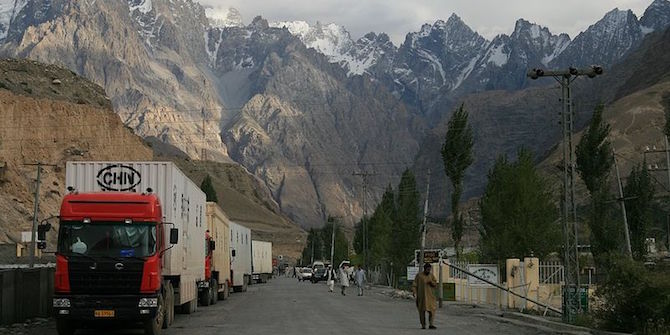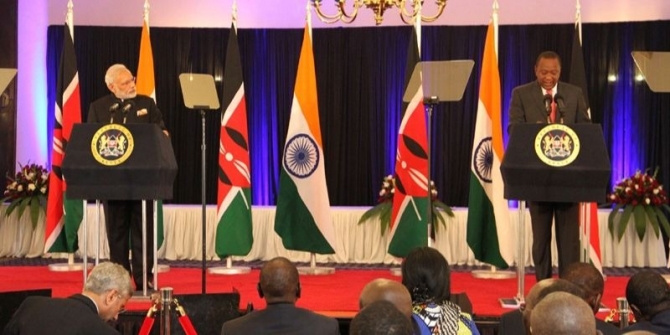In An Economist In The Real World, Chief Economist of the World Bank Kaushik Basu seeks to explain Indian policymaking in layman’s terms. Ankita Mukhopadhyay writes that the book deftly delves into the complexities of the Indian economy. However, she warns that while the author is an excellent storyteller, a reader without a background in economics may find it hard to follow the more theoretical sections of the book.
An Economist In The Real World: The Art of Policymaking in India. Kaushik Basu. MIT Press. 2015.
 Documenting India’s growth story is always an uphill task, primarily because it is not an easy one to unpick. An attempt to calculate its future is complicated by the huge and growing population, and the vast, unruly administrative system mired in corruption. Professor Ramachandra Guha has always stated that India is the world’s most unlikely democracy. Its continuing existence, despite many flaws, runs contrary to many of the theories of democracy laid out by political scientists.
Documenting India’s growth story is always an uphill task, primarily because it is not an easy one to unpick. An attempt to calculate its future is complicated by the huge and growing population, and the vast, unruly administrative system mired in corruption. Professor Ramachandra Guha has always stated that India is the world’s most unlikely democracy. Its continuing existence, despite many flaws, runs contrary to many of the theories of democracy laid out by political scientists.
As a student of history, I was a little skeptical of the viewpoints Kaushik Basu would be putting forth in his new book, An Economist In The Real World, primarily because augmenting statistically or even economically India’s state of policymaking is difficult without taking the social milieu into account. This book documents Basu’s experience in India during his years as the Chief Economic Adviser for the Manmohan Singh government. It begins with Basu’s own journey in India after holding visiting professorships at various international universities, and ends with his theory behind tackling corruption through a methodology that he crafted while on the job.
Needless to say, the book does cover the most integral aspects of India’s policymaking history and likely future. Basu deftly delves into the problem of dealing with a country like India and a discipline like economics at the same time. In the author’s words, ‘economics is a strange discipline because it has one foot in science and one in intuition and common sense. As a consequence, everyone has a view about how to conduct economic policy.’
Basu brings a surprising element of humour to India’s growth story by comparing what is lacking in the Indian policymaking scene to a Bengali fish recipe, where the author has forgotten to mention why ginger and onions should be ground into paste and for what purpose. What is remarkable about Basu as an author is that he may be a confident and assertive speaker, but he is a more gentle writer. The book gains momentum slowly, allowing the reader to absorb the economic theories he introduces, without getting tired.
The first chapter traces India’s economic growth story – from the heady Indira Gandhi days to the 1991 Narasimha Rao government that is responsible for opening up the Indian economy to the world. India’s growth story is different from China’s – growth was largely stagnant in the decades following independence, which led Raj Krishna of the Delhi School of Economics to coin the term ‘Hindu rate of growth’ and argue that ‘it was written somewhere in the scriptures’ that the people of India were ‘destined to never see their economy grow faster than 3.5 percent per annum’.
Yet India’s growth sped up suddenly in 1975-76, when the rate hit a startling 9 percent. This has been linked to the political turmoil at the time and Prime Minister Indira Gandhi’s Emergency. Prior to the Emergency, the first oil crisis had struck India in 1973, and inflation escalated to a record high of 30%. While Basu admits that it is tough to explain the high growth rate during the Emergency, he does postulate that the fear of being seen as inefficient and landing in jail brought about a certain level of efficiency in the economy. Even small factors such as more punctual trains during this period could be argued to have contributed to economic growth.
The author’s insight is powerful because he recognises the role of even the seemingly minutest elements and believes that they all have their own specific impact on the economy. While China’s growth story is another exponential one, Basu believes that India’s changing political theatre was a major reason why India couldn’t match the massive rate of 10.30% to 16.4% that China grew between 1963 to 1965. Without wasting much time delving into the changing economic metrics of Indira Gandhi’s rule, he races to 1991 – outlining that the major change during this period was to weave the revocation of the licensing system into the packaging of reform measures. The notorious ‘licensing system’ stipulated that if someone wanted to start up a new industry or even just expand production beyond a certain level, they had to get a permit or a ‘license’. This led to notorious bureaucratic hurdles and fertile ground for corruption. Scrapping the licensing system therefore played a key role in reinvigorating economic growth in the 1990s.
The sub-chapters of the book deal with topics like inflation, fiscal, macroeconomic policies for an emerging economy, globalisation and the challenge of development, food and poverty and the social and organisational foundations of economic development. Even teacher absenteeism is discussed. Each chapter offers a detailed observation of what Basu wants the reader to understand of the Congress government, much misunderstood between the 10 years it was in power. For example, Basu points out that though inflation in India was high during the Congress years, it never crossed the double digit mark or became unbearable for the populace. He also proposes a solution for a problem like inflation, namely that a certain amount needs to be confiscated from the populace for a certain amount of time. This can take the form of a 5% temporary income tax, which is then held by the Government without being put to use and eventually paid back to the taxpayers over the next four or five years, once the inflation eases.
Basu also lineates a solution for the food crisis in India, by proposing a legal ‘coupon’ system, that can empower the household with the decision as to whether they want to spend them or not, thus eliminating the problem of hoarding to a certain extent. He also proposes the use of technology, to make the process more secure, like the use of mobile banking executed from one’s cell-phone.
Ultimately, what stands out in the book is a theory Basu had infamously detailed on the Ministry of Finance website to tackle corruption, using Beker’s concept and game theory. The majority of bribes in India are ‘harassment bribes’ and they can be tackled using this model, where only the person receiving the bribe is punished, not the giver. That way, those requesting the bribes are more cautious as those who are forced to give the bribe are more likely to report them (it was this theory that Basu outlined in detail when he spoke at LSE in 2015 – see my South Asia @ LSE write up of the event here).
While Basu is an excellent storyteller, the economist in him can mire the reader in economic theories, making it difficult to comprehend the actual argument at times. There are instances where someone without a degree-level economics background can find themselves lost. An eye for the discipline is therefore needed if one wants to read the book cover to cover.
Overall, the book is an experience for the reader, as much as advising on the Indian economy was an experience for the author!
Kaushik Basu spoke at LSE in March 2015. Read the blog write up here and listen to the full podcast of the lecture here.
Note: This article gives the views of the author, and not the position of the South Asia @ LSE blog, nor of the London School of Economics. Please read our comments policy before posting.
About the Author
 Ankita Mukhopadhyay recently completed an MSc in History of International Relations at LSE. Her dissertation at LSE, titled, ‘Post-war restructuring of youth health and cultural politics: British rehabilitation policies in occupied Germany, 1945-1948’ was awarded distinction. She did her undergraduate degree in History (Hons.) from Lady Shri Ram College, New Delhi and now works as the Lead of Content at a startup in Gurgaon, India. She tweets @muk_ankita.
Ankita Mukhopadhyay recently completed an MSc in History of International Relations at LSE. Her dissertation at LSE, titled, ‘Post-war restructuring of youth health and cultural politics: British rehabilitation policies in occupied Germany, 1945-1948’ was awarded distinction. She did her undergraduate degree in History (Hons.) from Lady Shri Ram College, New Delhi and now works as the Lead of Content at a startup in Gurgaon, India. She tweets @muk_ankita.







